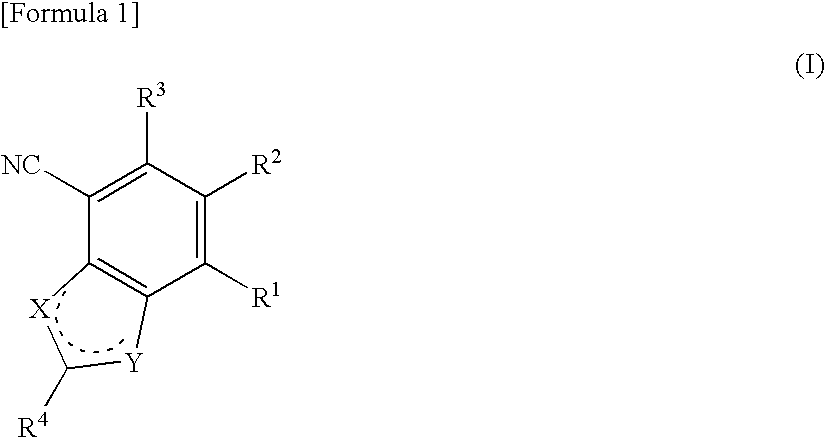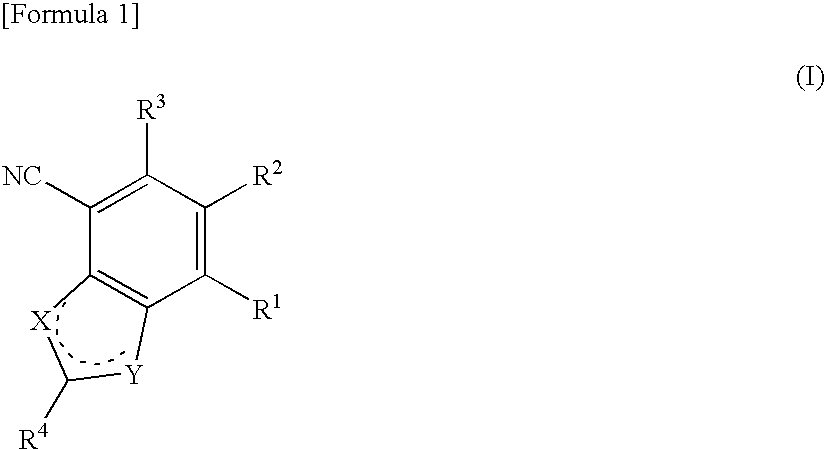Antifungal bicyclic hetero ring compounds
a technology of hetero-ring compounds and antifungal drugs, which is applied in the direction of hetero-ring active ingredients, antibacterial agents, biocide, etc., can solve the problems of narrow antifungal spectrum, increasing cases of profound mycosis, and much effort paid to the development of antifungal drugs
- Summary
- Abstract
- Description
- Claims
- Application Information
AI Technical Summary
Benefits of technology
Problems solved by technology
Method used
Image
Examples
reference example 1
N-(3-Bromo-2-methoxy-5-methylphenyl)-2-hydroxyiminoacetamide (I-1)
[0144]Produced according to the method described in literature (Eur. J. Med. Chem., 34, 729 (1999)).
[0145]An N,N-dimethylformamide (5 ml) solution of 3-bromo-2-methoxy-5-methylaniline (467 mg, 2.16 mmol), concentrated hydrochloric acid (268 μl) were added to an aqueous (11 ml) solution of trichloroacetaldehyde monohydrate (715 mg, 4.32 mmol), anhydrous sodium sulfate (2.46 g, 17.3 mmol), followed by stirring at 90° C. for 25 minutes. Hydroxylamine hydrochloride (901 mg, 13.0 mmol) was added to it, followed by stirring overnight at 90° C.
[0146]After cooling, water (50 ml) was added, and the product was extracted with ethyl acetate (100 ml×2), the organic layer was washed with saturated brine (50 ml), dried over anhydrous magnesium sulfate, concentrated under reduced pressure. The residue was purified by silica gel column chromatography (n-hexane:ethyl acetate=3:1) to obtain the entitled compound (278 mg, 45%) as a yell...
reference example 2
6-Bromo-7-methoxy-4-methyl-1H-indole-2,3-dione (I-2)
[0149]Produced according to the method described in literature (Eur. J. Med. Chem., 34, 729 (1999)).
[0150]Polyphosphoric acid (2.97 g) was added to N-(3-bromo-2-methoxy-5-methylphenyl)-2-hydroxyiminoacetamide (I-1) (260 mg, 906 μmol), followed by stirring at 80° C. for 3 hours. Ice (about 10 g) was put into the reaction liquid, then water (30 ml) was added and the product was extracted with ethyl acetate (70 ml×2). The organic layer was washed with saturated brine (50 ml×2), then dried over anhydrous magnesium sulfate, concentrated under reduced pressure. The residue was purified by silica gel column chromatography (n-hexane:ethyl acetate=3:1→3:2) to obtain the entitled compound (103 mg, 42%) as an orange solid.
[0151]MS (FAB) m / z: 270 (M+1 for 79Br)+, 272 (M+1 for 81Br)+.
[0152]1H-NMR (DMSO-d6) δ: 2.38 (3H, s), 3.73 (3H, s), 7.16 (1H, s), 11.41 (1H, brs).
reference example 3
2-Amino-4-bromo-3-methoxy-6-methylbenzoic acid (I-3)
[0153]Produced according to the method described in literature (Eur. J. Med. Chem., 34, 729 (1999)).
[0154]6-Bromo-7-methoxy-4-methyl-1H-indole-2,3-dione (I-2) (92.3 mg, 342 μmol) was dissolved in 1,4-dioxane (1.5 ml), at 0° C., aqueous hydrogen peroxide (175 μl, 30%, d=1.11, 1.71 mmol), aqueous 0.67 N sodium hydroxide solution (6.38 ml, 4.27 mmol) were added, followed by stirring for 3 hours with gradually heating. Acetic acid was added to the reaction liquid for controlling at pH of 4 to 5, saturated brine (50 ml) was added, the product was extracted with ethyl acetate (50 ml×2). The organic layer was washed with saturated brine (50 ml), then dried over anhydrous magnesium sulfate, concentrated under reduced pressure, the residue was purified by silica gel column chromatography (chloroform:methanol=50:1) to obtain the entitled compound (72 mg, 80%) as a yellow solid.
[0155]MS (FAB) m / z: 260 (M+1 for 79Br)+, 262 (M+1 for 81Br)+.
[015...
PUM
 Login to View More
Login to View More Abstract
Description
Claims
Application Information
 Login to View More
Login to View More - R&D
- Intellectual Property
- Life Sciences
- Materials
- Tech Scout
- Unparalleled Data Quality
- Higher Quality Content
- 60% Fewer Hallucinations
Browse by: Latest US Patents, China's latest patents, Technical Efficacy Thesaurus, Application Domain, Technology Topic, Popular Technical Reports.
© 2025 PatSnap. All rights reserved.Legal|Privacy policy|Modern Slavery Act Transparency Statement|Sitemap|About US| Contact US: help@patsnap.com



